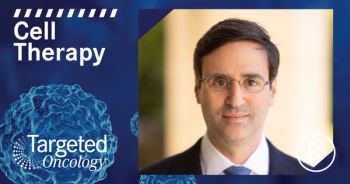
Case 3: PARP Inhibition in Recurrent Ovarian Cancer
EXPERT PERSPECTIVE VIRTUAL TUMOR BOARD
Robert L. Coleman, MD:Let’s talk a little about her treatment. She has had primary treatment with bevacizumab, got bevacizumab maintenance, and had a long treatment-free interval, which is impressive. And then she was reinduced, because of her multifocal disease, with docetaxel and carboplatin. Now it looks as if she’s achieved a partial response that is not quite as robust as she saw the first time around. At this period of time, we’ve identified her as a wild type for germline. We don’t know what her somatic data are, but it does raise the point of: What’s the best therapy, at that point? I think we could have introduced basically the same discussion that we had in the first line in the second line because she’s known to be a wild-type patient. And with OCEANS and GOG-213, we’ve demonstrated that bevacizumab given with paclitaxel and platinum-based therapies, as combinations, can lead to an improvement in progression-free survival and, to some degree, a potential overall survival trend, as in GOG-213, with that combination.
Now we have some newer studies that looked at PARP [poly (ADP ribose) polymerase] inhibitors in this setting. Maybe we can go around the table and review each of those studies? So ARIEL3, a trial that I was fortunate to be the PI [principal investigator] for with Dr Jonathan Ledermann, was a trial that was done looking at basically the same population. This was the use of rucaparib versus placebo in a 2:1 randomization in a population that includedBRCApatients, a group of patients we called HRD [homologous recombination deficiency], and then, essentially, an all-comers population that was all the patients who complement that. There was a very robust response regarding data for progression-free survival.
In the study, we showed that even in patients who had residual disease, like this patient, objective responses were seen. Again, this kind of highlighted the data that we’ve known for a whilethat these drugs do have efficacy, even in patients we know are not germline carriers. And certainly, that could come from those who have this HRD signature or even among the wild-type patients for whom we really don’t know why they work. But we do see some efficacy, even in them.
Dave, maybe you could take us through the NOVA study, which was really the first of these 3 trials that came out in the last couple of years. How was that trial set up?
David O’Malley, MD:It was actually set up as 2 parallel trials1 germline, and those with nongermlineBRCAmutationsand enrolled 2:1. They were able to have partial or complete responses. They did not have to normalize their CA 125 [cancer antigen] but did have to have response and were not allowed to go on with bulky or measurable disease. So when we looked at those patient populations, in the non-BRCAthey also looked at HRD using the Myriad Genetics, Inc HRD test and did essentially 3 separate analyses: The germline, HRD, and then the non-HRD patients. And they actually saw a benefit in all those populations. They saw the most incremental benefit in the germlineBRCApatients, but then also HRD and, next, the wild type. Interestingly, there were not statistical differences between the HRD and the wild type, but there was an incremental improvement.
Robert L. Coleman, MD:Can you briefly take us through SOLO2.
Susana M. Campos, MD, MPH:It’s a little bit different than, of course, the ARIEL3 and the NOVA trials. The SOLO2 trial was recurrent disease, platinum sensitive, but basically was forBRCAmutation carriers onlydrug or no drug. And Study 19, which kind of got lumped into this whole picture, really was all-comers. When the data were actually looked at all at once, the data were exactly parallel to all the other trials. There was a progression-free survival benefit for the use of olaparib as part of SOLO2 forBRCAmutation carriers, but there was also a benefit for olaparib in all-comers in Study 19. In many ways, those 2 studies were put together and looked upon favorably because they said exactly what NOVA had said at that point in time. I think it’s very important to say and to highlight that these are 3 studies. The eligibility criteria were somewhat similar, the design was very different, and toxicities may be different.
Robert L. Coleman, MD:Right, and even in how they were assessed, right?
Susana M. Campos, MD, MPH:Absolutely.
Robert L. Coleman, MD:NOVA used what we call a BICR, or a blinded independent central radiology review process. SOLO2 and ARIEL3 are investigator assessments. I think it makes it a little more difficult to kind of compare what the absolute values of those curves are. But I think that, in general, the hazard ratios of them are very, very consistent and I think demonstrate a very strong effect in this patient population.
David O’Malley, MD:I was just going to say it’s a very important point, with regard to the assessments and the differences between, particularly when you’re looking at the median progression-free survivals. This is really the first time in my career that I’m starting to engage in hazard ratios because I really think they’re effective. The progression-free survival is nice. We are starting to figure out that hazard ratios are important, as you’ve been telling me for how long?
Transcript edited for clarity.








































